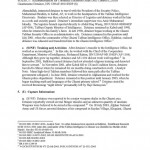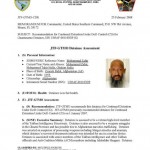President Obama and his administration continue to support the global Islamist militant group known the Muslim Brotherhood. A White House strategy document regards the group as a moderate alternative to more violent Islamist groups like al Qaeda and the Islamic State.
The policy of backing the Muslim Brotherhood is outlined in a secret directive called Presidential Study Directive-11, or PSD-11. The directive was produced in 2011 and outlines administration support for political reform in the Middle East and North Africa, according to officials familiar with the classified study.
Efforts to force the administration to release the directive or portions of it under the Freedom of Information Act have been unsuccessful.
Gulf News in the Middle East reports the same in 2014.
US document reveals cooperation between Washington and Brotherhood Studies commissioned by the president concluded that the US should back ‘moderate Islamists’ in the region
Dubai: For the past decade, two successive US administrations have maintained close ties to the Muslim Brotherhood in Egypt, Tunisia, Syria and Libya, to name just the most prominent cases. The Obama administration conducted an assessment of the Muslim Brotherhood in 2010 and 2011, beginning even before the events known as the “Arab Spring” erupted in Tunisia and in Egypt.
The President personally issued Presidential Study Directive 11 (PSD-11) in 2010, ordering an assessment of the Muslim Brotherhood and other “political Islamist” movements, including the ruling AKP in Turkey, ultimately concluding that the United States should shift from its longstanding policy of supporting “stability” in the Middle East and North Africa (that is, support for “stable regimes” even if they were authoritarian), to a policy of backing “moderate” Islamic political movements. To this day, PSD-11 remains classified, in part because it reveals an embarrassingly naïve and uninformed view of trends in the Middle East and North Africa (Mena) region. The revelations were made by Al Hewar centre in Washington, DC, which obtained the documents in question. Through an ongoing Freedom of Information Act (FOIA) lawsuit, thousands of pages of documentation of the US State Department’s dealings with the Muslim Brotherhood are in the process of being declassified and released to the public. US State Department documents obtained under the FOIA confirm that the Obama administration maintained frequent contact and ties with the Libyan Muslim Brotherhood.
At one point, in April 2012, US officials arranged for the public relations director of the Libyan Muslim Brotherhood, Mohammad Gaair, to come to Washington to speak at a conference on “Islamists in Power” hosted by the Carnegie Endowment for International Peace. A State Department Cable classified “Confidential” report says the following: “Benghazi Meeting With Libyan Muslim Brotherhood: On April 2 [2012] Mission Benghazi met with a senior member of the Muslim Brotherhood steering committee, who will speak at the April 5 Carnegie Endowment `Islamist in Power’ conference in Washington, D.C. He described the Muslim Brotherhood’s decision to form a political party as both an opportunity and an obligation in post-revolution Libya after years of operating underground.
The Brotherhood’s Justice and Construction Party would likely have a strong showing in the upcoming elections, he said, based on the strength of the Brotherhood’s network in Libya, its broad support, the fact that it is a truly national party, and that 25 per cent of its members were women. He described the current relationship between the Brotherhood and the TNC (Transitional National Council) as `lukewarm.’” Another State Department paper marked “Sensitive But Unclassified (SBU)” contained talking points for Deputy Secretary of State William Burns’ scheduled July 14, 2012 meeting with Mohammad Sawan, the Muslim Brotherhood leader who was also head of the Brotherhood’s Justice and Construction Party. The document is heavily redacted, but nevertheless provides clear indication of Washington’s sympathies for the emergence of the Muslim Brotherhood as a major political force in the post-Gaddafi Libya. The talking points recommended that Secretary Burns tell Sawan that the US government entities “share your party’s concerns in ensuring that a comprehensive transitional justice process is undertaken to address past violations so that they do not spark new discontent.” The Burns paper described the Libyan Muslim Brotherhood: “Prior to last year’s revolution, the Muslim Brotherhood was banned for over three decades and its members were fiercely pursued by the Gaddafi regime.
The Libyan Muslim Brotherhood (LMB) returned to Libya last year after years in exile in Europe and the United States, selected new leadership and immediately began to plan for an active role in Libya’s political future.” After a redacted section, the document continued, “The LMB-affiliated Justice and Construction party, led by Misratan and former political prisoner under Gaddafi Mohammad Sawan, was created in March 2012. Sawan himself was not a candidate in the elections but wields significant influence as the head of the largest political party and most influential Islamist party in Libya.” The July 14 meeting was attended by both Secretary Burns and Ambassador Christopher Stevens. On September 11, 2012, Ambassador Stevens and three other American diplomats were killed in a premeditated terrorist attack on US mission and CIA facilities in Benghazi. An undated State Department cable revealed further courting of the LMB and its Justice and Construction Party. “Mohammad Sawan, Chairman of Justice and Construction Party, received yesterday at his office in Tripoli, Ambassadors of US, UK, FR and IT. The Ambassadors requested the meeting to get acquainted with the party’s position on the current events in Libya, the Government, the Party’s demand to sack the Prime Minister, the Constitution, GNC lifetime arguments, dialogue initiatives and Party’s assessment of political and security situation in Libya and the region. During the meeting, which took an hour and a half and attended by Mohammad Talb, party’s International Relations officer, and Hussam Naeli, acting liaison officer, Sawan explained that the Government has not been able to achieve any success in the core files such as security and local government, which both are under the direct supervision of the Prime Minister. Such a failure resulted in the lack of security, continuous assassinations, kidnappings, crimes, smuggling and attacks on public and private property, halt oil exports and disruption of water and electricity supply. Sawan stressed that a solution is possible and the party presented a clear solution, but the Government is not in harmony. He added we are responsible only for ministries that we take part in.”
The State Department cable noted that “On their part, the Ambassadors praised the active role of the Party in the political scene and confirmed their standing with the Libyan people and Government despite its weaknesses and they are keen to stabilize the region… At the end of the meeting, Sawan thanked his guests and all stressed the need to communicate. The guests affirmed that they will assist through Libyan legitimate entities as they did during the revolution.”


